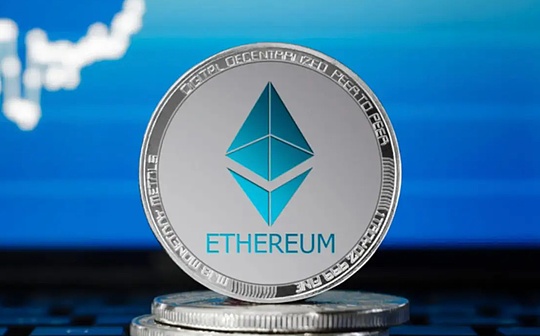
Written by: Ignas, DeFi Research; Compiled by: J1N, Techub News
The market now has good reason to be bearish on Ethereum.Because SOL has risen 6.8 times higher than Ethereum since the market lows in early 2023, and the ETH/BTC trading pair has fallen 47% in the past two years.
Is it time for Ethereum to rebound?
Ethereum’s bearish reason
There are many different opinions on the reasons for Ethereum’s poor performance, but I think several of the important reasons are as follows:
Bitcoin is “digital gold”, and this concept is easy to understand for retail investors and institutions.In contrast, the story of Ethereum is more complicated.The market uses “digital oil” as a name, neither attractive nor accurate.
-
Solana is catching up and even surpassing Ethereum in terms of active users, transaction volume and awareness.
-
When investors choose to invest in cryptocurrency varieties, Bitcoin will be a more insurable option, while Solana is a potential and relatively low market capitalization option.Ethereum is sandwiched between the two.
-
Ethereum’s modularity and L2 split liquidity from capital and complicate the user experience.
-
The modular system makes it necessary for investors to spread their funds across various derivative tokens in Ethereum, such as multiple L2, LRT tokens and DA tokens.By contrast, in the same case, users on Solana only need to buy SOL.
I believe Ethereum will outperform Bitcoin because the market is aware of the high returns of the POS mining mechanism.Based on the airdrop income from the restake agreement alone, I think Ethereum’s current price is seriously undervalued.
However, this did not bring about FOMO effect to Ethereum, which may be due to the overexposed and traffic of the Ethereum ecosystem during the past bear market. Many people believe that Ethereum will not fail and buy in large quantities.
On the contrary, few Crypto Native hold SOLs.When SOL rebounded, this group of people turned their funds from Ethereum to SOL more.Ethereum’s price has stalled without a large amount of retail capital inflows.
Another problem is the decline in Ethereum staking income and destruction rates.
After the upgrade of EIP-4884 Proto-danksharding, the Gas fee for L2 decreased, resulting in a reduction in Ethereum’s destruction rate.Although Ethereum’s inflation rate is still below 1%, this situation is not optimistic for those who are optimistic about Ethereum as an “ultrasound money”.
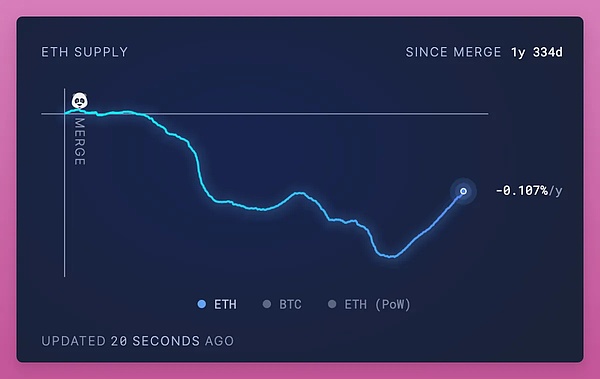
It can be clearly seen that after the release of EIP-4844 in March, the destruction trend of Ethereum reversed.
Currently, there are few “ultrasound money” Memecoin on Twitter.Bearish comments are flooding Twitter, but Ethereum’s bullish sentiment remains, although not as strong as Bitcoin.

Instead, let’s discuss Ethereum’s bullish argument.
Ethereum bullish argument
There are many reasons to be bullish on Ethereum, and I ask fans on Twitter to share their views.

Before sharing, I will summarize your views into the following 10 points.
-
If the Gas price remains around 20 Gwei, Ethereum is deflationary, thus becoming an attractive and efficient network.It is worth noting that since March, Ethereum’s Gas price has been below 20 Gwei.
-
Retail investors can now also stake Ethereum at home, which attracts individual investors in consumer-grade hardware and increases the degree of network decentralization.
-
The powerful developer community and emerging new Idea in the Ethereum ecosystem support continuous innovation and network robustness.
-
Ethereum is the number one smart contract platform, ensuring reliability while ensuring decentralization and no real competitors.
-
Continuing development such as L2 and interoperability improvements are major positives, while the community is working to optimize fragmentation and improve network efficiency.
-
The increasing transparency of regulatory, especially in the United States and the European Union, has strengthened market confidence in Ethereum and enabled institutions such as BlackRock to adopt Ethereum.
-
Various LSD protocols allow all Ethereum holders to participate in protecting the network without technical knowledge or resources.
-
Large institutions such as Coinbase and BlackRock said that the tokenized applications of RWA on Ethereum will become increasingly popular.
-
There is huge room for growth for DeFi services and large stablecoin pools on Ethereum.
-
Ethereum holders and users regain their enthusiasm and collective pride and contribute to blockchain sermons and market education.
I also asked several well-known people among Ethereum holders and users why they are optimistic about Ethereum.Among them, Camila Russo (founder of The Defiant) and Christine Kim (Galaxy researcher) responded.
Here are the reasons why Camila Russo is optimistic about Ethereum:
-
Mature DeFi ecosystem: Ethereum and its second layer network have the most mature DeFi ecosystem in the entire cryptocurrency field.This liquidity and DApp concentration will attract more users, so that the impact of DeFi activity can be reflected on L1, thereby pushing up gas fees and consuming more Ethereum.DeFi is the key, because finance is one of the few cryptocurrency application scenarios with practical significance.
-
Decentralization and security: Ethereum’s decentralization and security have attracted the world’s largest asset managers, such as BlackRock’s BUIDL Fund, PayPal’s PYUSD, JPMorgan Chase, Santander and other large banksTest functions such as blockchain settlement and tokenization on Ethereum.Large institutions cannot bear the risk of blockchain downtime or validator/miner attacks and violations, so they will continue to choose Ethereum.This will drive activity development and price increases.
-
Ethereum Spot ETF: Ethereum is one of the only two cryptocurrencies that institutional investors in the United States can invest through ETFs, which will provide long-term support for Ethereum prices.
Christine Kim highlights the network effects of Ethereum:
I think one of Ethereum’s main advantages over its competitors is its network effect.Ethereum is the earliest general blockchain with first-mover advantage and has the largest developer community. I think both of these points will help enhance the value of the network.
In fact, I prefer to store long-term holdings on Ethereum.Solana has failed many times, and Ethereum has been performing reliably for many years.
In addition, I am very optimistic about Ethereum as a risk-weighted asset chain for RWA asset tokenization.For example, 52% of stablecoins and 73% of U.S. Treasury bonds are tokenized on Ethereum.
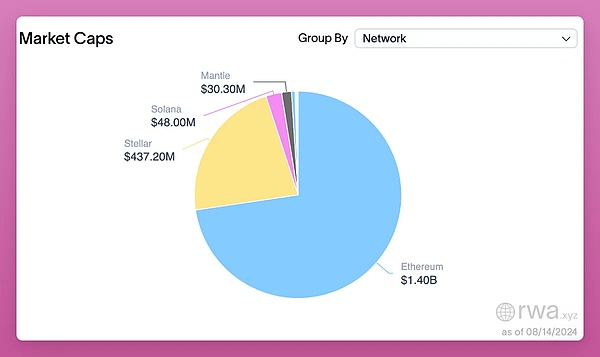
US Treasury Tokenization
If you are optimistic about Memecoins, Solana may be your choice, but for tokenized billion-dollar RWA, Ethereum is the safest choice.
Next, a big problem is the second level.
As a large-scale public chain, Solana is fast and affordable, but still has its shortcomings.
The modular expansion of L2 provides a long-term solution because modular expansion can be customized specifically for specific application scenarios, providing more L2’s flexibility, simplicity and cultural sovereignty space.Cygaar elaborates on this in the following post:

At present, due to the reliance on cross-chain bridges, liquidity is dispersed, which leads to poor user experience. I hope this is only temporary.For example, Catalyst AMM will allow atomic swaps between different chains, eliminating the need for bridge assets.In this case, liquidity remains dispersed and the end user can still get the best price even as liquidity comes from multiple chains.More solutions like Catalyst are under development.
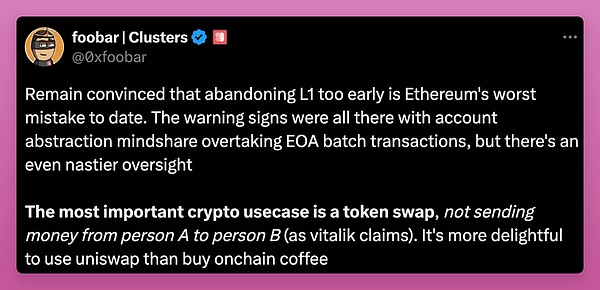
In addition, L2s itself is making greater efforts.
Optimism is “integrating with ERC-7683 to allow the hyperchain to interoperate with the rest of Ethereum L2 through the application layer”, which means that all L2s in the Optimism ecosystem will become a whole.
Similarly, Polygon is building an AggLayer, “this means one-click transactions across chains. It will recreate the on-chain experience.”
Then there are Caldera’s Metalayer, Avail Nexus and Hyperlane.
Even though multiple aggregation solutions have not yet been implemented, with the continuous development, future liquidity and user experience issues should be solved.
I think people underestimate how quickly this trend occurs.I recommend following Andy on Twitter to get the latest updates on modular expansion.
In addition, please read this Blocmates article to learn how to solve the problems of multiple current products.
In fact, Vitalik himself has said that people will be surprised to find that the “cross L2 interoperability” problem is no longer a problem.
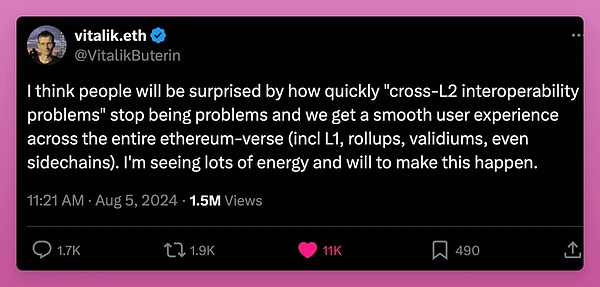
If you need to see more bullish views and reasons, check out Emmanuel’s post below.He is bullish because Ethereum has a strong community, continuous innovation and long-term adaptability.
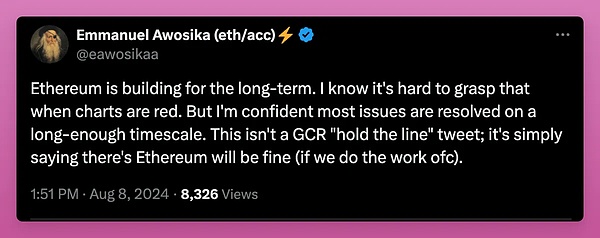
If the L2 fragmentation problem is solved and RWA and tokenized applications continue to grow on Ethereum, I will be very optimistic about Ethereum, but these are long-term factors.
In the short term, there is a bullish point that few people discuss: Pectra upgrade.
What is a Pectra upgrade?
The Pectra upgrade is an important milestone in the Ethereum upgrade route and is expected to be launched in the first quarter of 2025.It combines Prague (execution layer) and Electra (consensus layer) updates.

Pectra Upgrade Schedule
In the past, all major upgrades of Ethereum have attracted much attention, but this Pectra upgrade seems to be unwatched by the market.
I understand why.Ethereum has undergone major changes before: from PoW to PoS migration, Ethereum destruction startup, and EIP-4884.Although the scale of Pectra upgrades is not as large as the previous few times, there are also some interesting updates.
1. Account abstraction: ultimately improving user experience
One of the biggest changes in Pectra upgrades is how account processing is.
Currently, managing a wallet requires many tedious steps, from signing transactions to managing transaction fees in different networks.Through account abstraction, Pectra upgrades simplify the entire process.
EIP-3074 and EIP-7702 are two proposed improvements.EIP-3074 allows traditional wallets (external owned accounts or EOA) to interact with smart contracts, such as enabling bulk transactions and sponsored transactions.
EIP-7702 goes a step further, allowing EOA to temporarily act as a smart contract wallet during transactions.Temporary means that your EOA wallet becomes a smart contract wallet only during transactions.It works by adding smart contract code to the EOA address.Let’s take a look at the ideal operation:
-
You can directly redeem USDC for UNI in just one interaction, without approve.
-
DApp can pay Gas fees for users
-
Pre-apply the DApps that users want to use with their wallet and set expenditure limits
EIP-7702 written by Vitalik seems to have prioritized EIP-3074, which is also compatible with the implementation of AA.
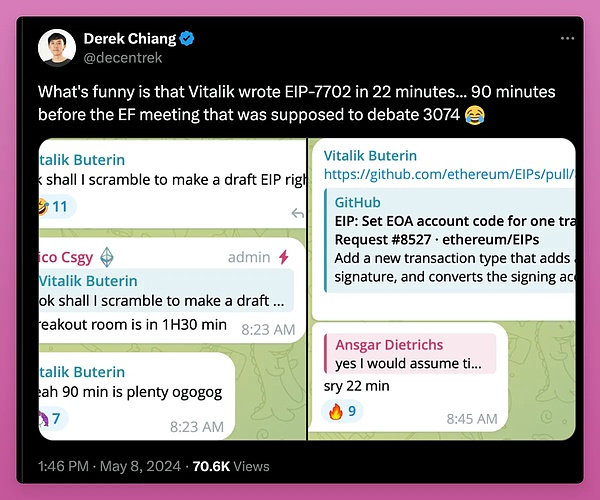
The idea “EOA becomes a smart contract temporarily” is cool because current DApps are usually incompatible with smart account wallets (try to use Safe or Avocado multi-signature with DApps).Hopefully, AA will get more attention after upgrading.
2. Equity pledge optimization
For users running the validator, the Pectra upgrade brings some significant changes.
EIP-7251 increases the maximum amount of validators’ collateral from 32 Ethereum to 2048 Ethereum.It allows large staking providers to consolidate their staking, reduce the number of validators and reduce network load.
This is also a plus for stakingers with smaller capital volumes, as it provides more flexible collateral options (can staking 40 Ethereum or compound rewards).Additionally, the queue for Ethereum staking will be reduced from hours to minutes.
One highlight that excites me has to do with MEV mitigation, but it doesn’t seem to be implemented in the Pectra upgrade.
3. Scalability improvements
Pectra introduces peer-to-peer data availability sampling (PeerDAS) through EIP-7594.
Like Proto-Danksharding in previous Dencun upgrades, PeerDAS will bring lower Gas fees on L2.But I can’t find data that it’s cheaper (I think PeerDAS will be especially useful during high usage).0xBreadguy mentioned that the Pectra upgrade will expand the blob capacity by 2-3 times.
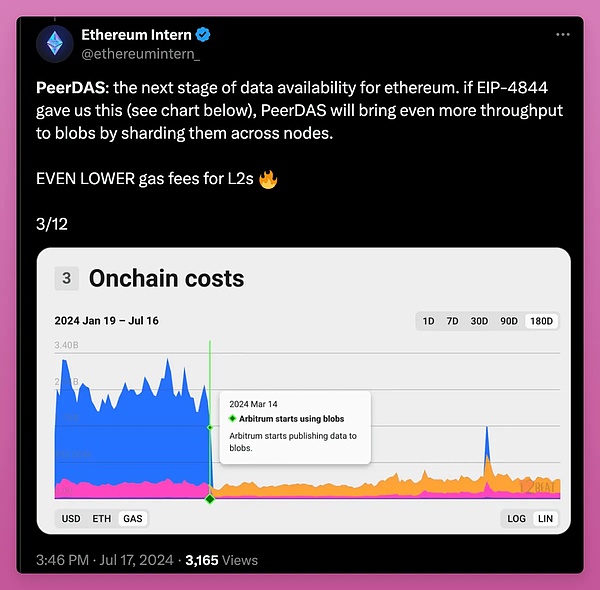
There are also a number of technical upgrades, such as BLS12-381 that shortens BLS signatures (reduces gas costs), and EIP-2935 that can verify transactions without the need for blockchain history.
Together with Verkle Trees Transition (EIP-6800), which will eventually replace the existing Merkle Tree structure, these EIP-6800 can make lightweight clients more secure and make nodes easier to participate in the network, thereby increasing decentralization.
One of the major changes is the EVM change, which will make it easier to write and deploy smart contracts, reduce costs and increase efficiency through 11 EIP standards.In other words, development on Ethereum will be smoother.
This tweet from Ethereum Intern briefly explains the impact of technology upgrades.
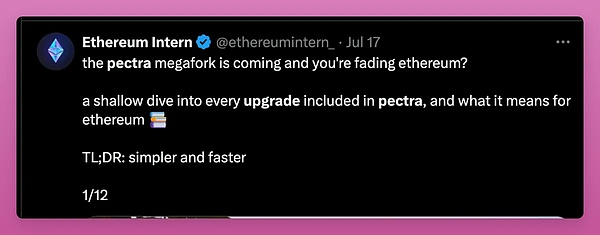
I’m glad that Single Slot (SSF) has finally been launched with the Pectra upgrade, but it’s not included in the next Osaka upgrade.
Vitalik shared in December 2023 that SSF is the easiest way to solve most of the flaws in Ethereum PoS design.
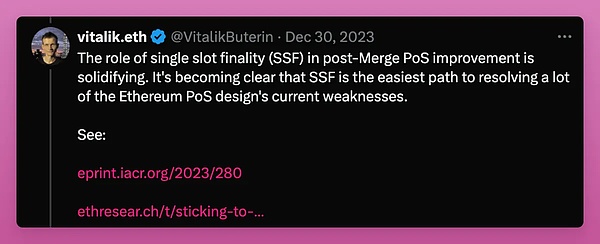
Currently, Ethereum’s proof-of-stake consensus mechanism takes about 15 minutes to complete the final confirmation of a block, which means that the block cannot be changed or deleted without substantial economic penalties.SSF attempts to reduce this time to a single slot for approximately 12 seconds, ensuring that the block completes final packaging confirmation almost immediately after creation.
In fact, this means faster and safer bridging, and faster recharge to CEX.Disappointingly, this has not been achieved yet.It is disappointing to not include this in the upgrade, as it shows that Ethereum developers have not yet made level one expansion a priority.
Anyway, the Pectra upgrade is a technological upgrade, but I think the market underestimates its importance.
Now, let’s talk about the price of Ethereum.
VanEck predicts that by 2030, Ethereum will reach $11,800.
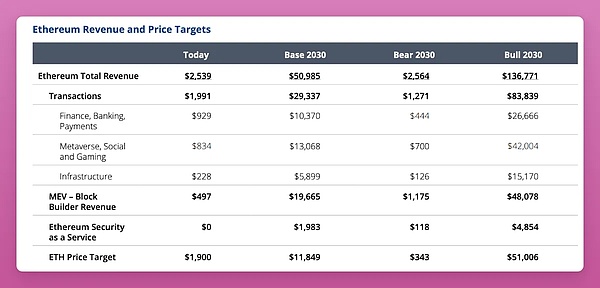
Honestly, the $11,800 price is quite conservative (I hope Ethereum will be higher), but remember, VanEck predicts that by 2030, the Solana will be priced at just $335.

Therefore, according to the basic forecast, Ethereum has a potential of 4.4 times, while SOL is only 2.2 times.Note that both forecasts were made a year ago before the launch of the Ethereum ETF, so I would love to see their latest forecasts.
By the way, if you need more bullish views, Ark Invest CEO Cathie Wood expects Ethereum to reach $166,000 and Bitcoin to reach $1.3 million by 2030.
However, it is realistic for me to see VanEck bullish Ethereum reaching $51,000.VanEck’s Ethereum price forecast is based on:
-
VanEck predicts that by 2030, Ethereum will occupy 70% of the market share of smart contract platforms by 2030.
-
Ethereum’s revenue is expected to grow from $2.6 billion to $51 billion per year by 2030.This increase is attributed to transaction fees, an increase in MEV and the launch of “SaaS” (SaaS), which uses Ethereum staking to protect other protocols (restaking).
-
Ethereum is expected to occupy more economic activity in finance, banking, payments, metaverse, social, gaming and infrastructure.
-
Ethereum’s potential as a store of value asset has been recognized, and its availability has been enhanced by smart contract programmability and cross-chain messaging technology.
The following is a summary of the basic, bear market and bull market scenarios.
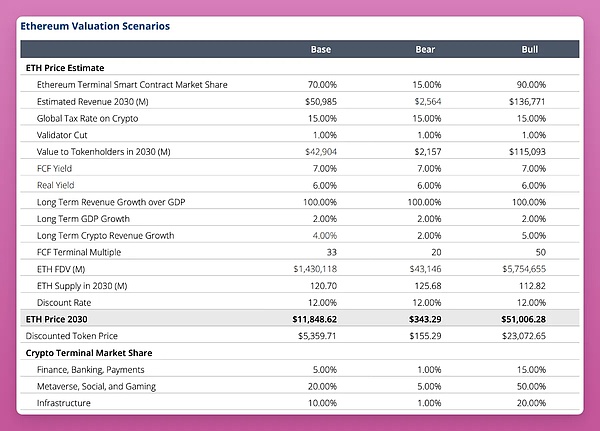
Ethereum accounts for 70% of the smart contract platform status, and although Ethereum currently dominates only 58%, it is about 65% with all secondary markets.Even though SOL has risen wildly, Ethereum’s dominance has remained unchanged since the beginning of 2022.
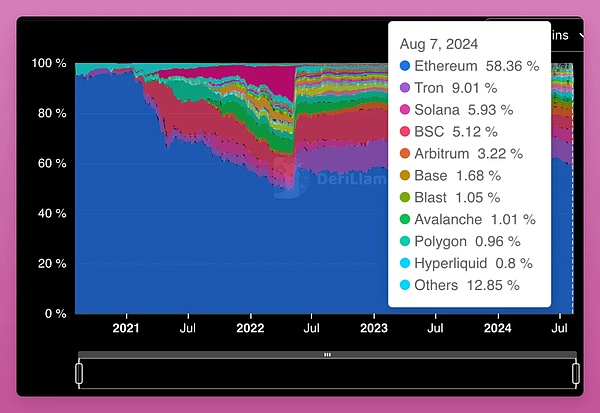
The proportion of TVL will be a key indicator because institutions are more concerned about this indicator.
Another indicator that institutions and retail investors are paying attention to is the traffic of Ethereum spot ETFs.
Ethereum Spot ETF
If someone told me a few months ago that Ethereum had spot ETFs but trading below $3000, I would think the market is in a bear market.
It’s too early to draw conclusions, but Ethereum spot ETFs seem to be increasingly bullish.The outflow rate of Grayscale Fund is declining rapidly, and the net flow has been positive for three consecutive days.It seems that those who need to withdraw from Grayscale Fund have already withdrawn.
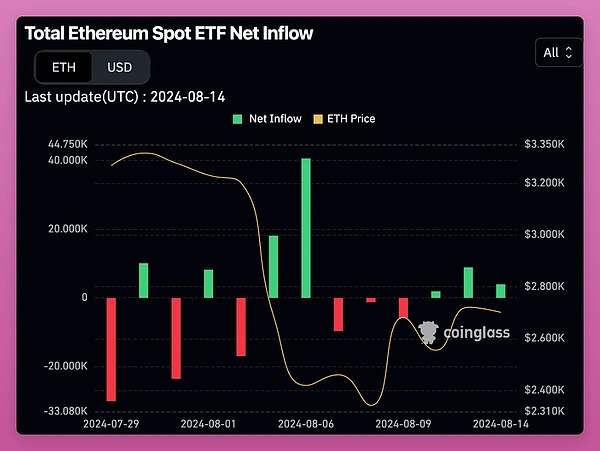
We already know the possible impact of grayscale, but the increase will be a big surprise.If this trend continues, I am quite optimistic about the future of Ethereum.


